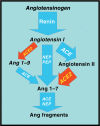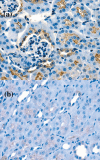Angiotensin converting enzyme 2 in the kidney
- PMID: 18307733
- PMCID: PMC7159125
- DOI: 10.1111/j.1440-1681.2008.04889.x
Angiotensin converting enzyme 2 in the kidney
Abstract
1. Angiotensin converting enzyme 2 (ACE2) is an important homeostatic component of the renin angiotensin system (RAS). ACE2 both degrades the vasoconstrictor, angiotensin II and generates the potent vasodilator peptide, angiotensin 1-7. These actions counterbalance those of ACE. 2. ACE2 is highly expressed in the healthy kidney, particularly in the proximal tubules, where it colocalizes with ACE and angiotensin receptors. 3. Kidney disease and subtotal nephrectomy is associated with a reduction in renal ACE2 expression, possibly facilitating the damaging effects of angiotensin II in the failing kidney. Acquired or genetic ACE2 deficiency also appears to exacerbate renal damage and albuminuria in experimental models, supporting this hypothesis. 4. ACE2 also has an important role in blood pressure control. Many models of hypertension are associated with reduced ACE2 expression. Although ACE2 KO animals are normotensive, in states associated with activation of the RAS, ACE2 overexpression improves blood pressure control and reduces angiotensin responsiveness.
Figures




References
-
- Donoghue M, Hsieh F, Baronas E et al A novel angiotensin‐converting enzyme‐related carboxypeptidase (ACE2) converts angiotensin I to angiotensin 1–9. Circ. Res. 2000; 87: E1–9. - PubMed
-
- Turner AJ, Hooper NM. The angiotensin‐converting enzyme gene family: Genomics and pharmacology. Trends Pharmacol. Sci. 2002; 23: 177–83. - PubMed
-
- Tipnis SR, Hooper NM, Hyde R, Karran E, Christie G, Turner AJ. A human homolog of angiotensin‐converting enzyme – Cloning and functional expression as a captopril‐insensitive carboxypeptidase. J. Biol. Chem. 2000; 275: 33 238–43. - PubMed
Publication types
MeSH terms
Substances
LinkOut - more resources
Full Text Sources
Other Literature Sources
Research Materials
Miscellaneous

